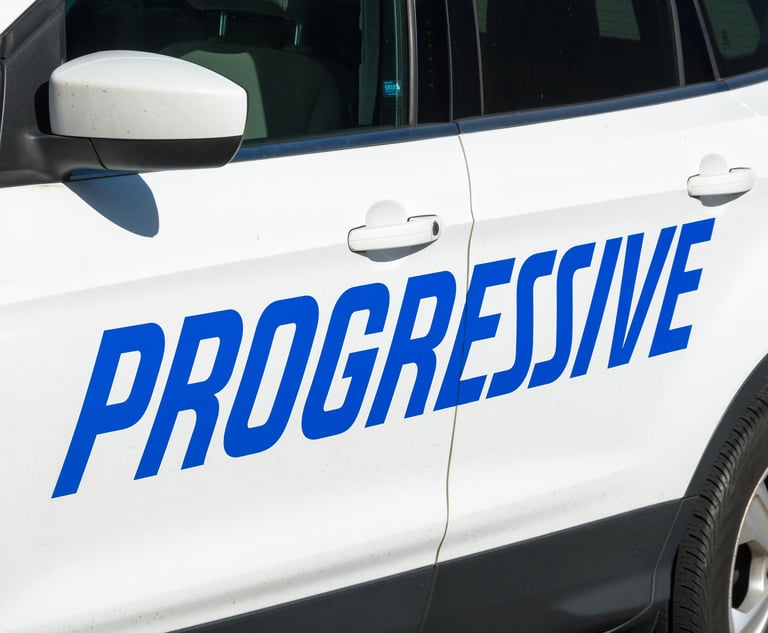Auto Policy Did Not Cover 'Stigma Damages,' California District Court Decides
A federal judge in California has ruled that an automobile insurance policy that provided liability coverage for “property damage” did not cover nonphysical “stigma damage” to an automobile that had been struck by another vehicle.
February 20, 2019 at 11:01 AM
4 minute read

This story is reprinted with permission from FC&S Legal, the industry's only comprehensive digital resource designed for insurance coverage law professionals. Visit the website to subscribe.
A federal district court in California has ruled that an automobile insurance policy that provided liability coverage for “property damage” did not cover nonphysical “stigma damage” to an automobile that had been struck by another vehicle.
The Case
After William Leroy Hennessy struck Jay Photoglou's vehicle, Mr. Photoglou made a claim for the damage.
Mr. Hennessy's insurer, Infinity Insurance Company, paid to repair the physical damage to Mr. Photoglou's vehicle but refused to pay for the alleged additional decrease in market value to his car due to nonphysical “stigma damages.”
Mr. Photoglou sued Mr. Hennessy in small claims court seeking those additional damages, which Mr. Photoglou labeled as “[d]iminished value to vehicle due to 'stigma/diminished value' as a result of the hit and run police report and its affect [sic] on public records such as 'CarFax' but not limited to 'CarFax.'”
Mr. Hennessy and Mr. Photoglou stipulated to the entry of judgment against Mr. Hennessy in the amount of $10,000 “for diminished value.”
Mr. Hennessy sought to have the judgment paid by Infinity, which refused on the ground that inherent diminished value, or “stigma damages,” were not covered by Mr. Hennessy's insurance policy.
Mr. Hennessy then sued Infinity for, among other things, breach of contract.
Infinity moved for summary judgment.
The Infinity Policy
The Infinity insurance policy provided liability coverage for “property damage,” defined as:
physical damage to tangible property, including destruction or loss of its use, which is caused solely by an accident covered under this policy and occurring while the policy is in force.
The District Court's Decision
The district court granted Infinity's motion.
In its decision, the district court found that the terms of Infinity's insurance contract and the meaning of those terms were “clear from the document's plain language.”
The district court reasoned that the Infinity policy provided coverage for “property damage,” meaning “physical damage to tangible property.” The district court ruled that diminution in value – also known as “stigma damages” – was “not itself a form of physical damage.”
The district court added that an insurance policy that did not cover stigma damages did not conflict with California's insurance law.
Accordingly, the district court concluded, to the extent Mr. Hennessy's claim was premised on a breach of the duty to pay, the “plain language of the contract” conclusively established that Infinity had no duty to pay under these circumstances, and Mr. Hennessy's complaint against Infinity failed to state a claim.
The case is Hennessy v. Infinity Ins. Co., No. CV 18-9323-R (C.D. Cal. Jan. 28, 2019). Attorneys involved include: For William Leroy Hennessy, Individually, on Behalf of All Others Situated and the State of California, Plaintiff: Montie S Day, LEAD ATTORNEY, Day Law Offices, Reno, NV; George E Mardikian, Day Law Offices, Reno, NV; Itamar B Tehrani, State Law Firm APC, Encino, CA. For Infinity Insurance Company, Defendant: Ara DerHartonian, Charles A Danaher, Theona Zhordania Sheppard Mullin Richter and Hampton LLP, Los Angeles, CA.
Steven A. Meyerowitz, Esq., is the Director of FC&S Legal, the Editor-in-Chief of the Insurance Coverage Law Report, and the Founder and President of Meyerowitz Communications Inc. As FC&S Legal Director, Mr. Meyerowitz, a member of the team that conceptualized FC&S Legal, provides daily analysis and commentary on the most significant insurance coverage law decisions from courts across the country and news regarding legislative and regulatory developments. A graduate of Harvard Law School, Mr. Meyerowitz was an attorney at a prominent Wall Street law firm before founding Meyerowitz Communications Inc., a law firm marketing communications consulting company.
This content has been archived. It is available through our partners, LexisNexis® and Bloomberg Law.
To view this content, please continue to their sites.
Not a Lexis Subscriber?
Subscribe Now
Not a Bloomberg Law Subscriber?
Subscribe Now
NOT FOR REPRINT
© 2025 ALM Global, LLC, All Rights Reserved. Request academic re-use from www.copyright.com. All other uses, submit a request to [email protected]. For more information visit Asset & Logo Licensing.
You Might Like
View All
Texas Insurer Slaps Hinshaw & Culbertson With Legal Mal Claim Over $11 Million Personal Injury Jury Award
3 minute read
Insurers Dodge Sherwin-Williams' Claim for $102M Lead Paint Abatement Payment, State High Court Rules


'A Wake Up Call to the Life Insurance Industry:' California Sues Insurers
3 minute readTrending Stories
- 1'It's Not Going to Be Pretty': PayPal, Capital One Face Novel Class Actions Over 'Poaching' Commissions Owed Influencers
- 211th Circuit Rejects Trump's Emergency Request as DOJ Prepares to Release Special Counsel's Final Report
- 3Supreme Court Takes Up Challenge to ACA Task Force
- 4'Tragedy of Unspeakable Proportions:' Could Edison, DWP, Face Lawsuits Over LA Wildfires?
- 5Meta Pulls Plug on DEI Programs
Who Got The Work
Michael G. Bongiorno, Andrew Scott Dulberg and Elizabeth E. Driscoll from Wilmer Cutler Pickering Hale and Dorr have stepped in to represent Symbotic Inc., an A.I.-enabled technology platform that focuses on increasing supply chain efficiency, and other defendants in a pending shareholder derivative lawsuit. The case, filed Oct. 2 in Massachusetts District Court by the Brown Law Firm on behalf of Stephen Austen, accuses certain officers and directors of misleading investors in regard to Symbotic's potential for margin growth by failing to disclose that the company was not equipped to timely deploy its systems or manage expenses through project delays. The case, assigned to U.S. District Judge Nathaniel M. Gorton, is 1:24-cv-12522, Austen v. Cohen et al.
Who Got The Work
Edmund Polubinski and Marie Killmond of Davis Polk & Wardwell have entered appearances for data platform software development company MongoDB and other defendants in a pending shareholder derivative lawsuit. The action, filed Oct. 7 in New York Southern District Court by the Brown Law Firm, accuses the company's directors and/or officers of falsely expressing confidence in the company’s restructuring of its sales incentive plan and downplaying the severity of decreases in its upfront commitments. The case is 1:24-cv-07594, Roy v. Ittycheria et al.
Who Got The Work
Amy O. Bruchs and Kurt F. Ellison of Michael Best & Friedrich have entered appearances for Epic Systems Corp. in a pending employment discrimination lawsuit. The suit was filed Sept. 7 in Wisconsin Western District Court by Levine Eisberner LLC and Siri & Glimstad on behalf of a project manager who claims that he was wrongfully terminated after applying for a religious exemption to the defendant's COVID-19 vaccine mandate. The case, assigned to U.S. Magistrate Judge Anita Marie Boor, is 3:24-cv-00630, Secker, Nathan v. Epic Systems Corporation.
Who Got The Work
David X. Sullivan, Thomas J. Finn and Gregory A. Hall from McCarter & English have entered appearances for Sunrun Installation Services in a pending civil rights lawsuit. The complaint was filed Sept. 4 in Connecticut District Court by attorney Robert M. Berke on behalf of former employee George Edward Steins, who was arrested and charged with employing an unregistered home improvement salesperson. The complaint alleges that had Sunrun informed the Connecticut Department of Consumer Protection that the plaintiff's employment had ended in 2017 and that he no longer held Sunrun's home improvement contractor license, he would not have been hit with charges, which were dismissed in May 2024. The case, assigned to U.S. District Judge Jeffrey A. Meyer, is 3:24-cv-01423, Steins v. Sunrun, Inc. et al.
Who Got The Work
Greenberg Traurig shareholder Joshua L. Raskin has entered an appearance for boohoo.com UK Ltd. in a pending patent infringement lawsuit. The suit, filed Sept. 3 in Texas Eastern District Court by Rozier Hardt McDonough on behalf of Alto Dynamics, asserts five patents related to an online shopping platform. The case, assigned to U.S. District Judge Rodney Gilstrap, is 2:24-cv-00719, Alto Dynamics, LLC v. boohoo.com UK Limited.
Featured Firms
Law Offices of Gary Martin Hays & Associates, P.C.
(470) 294-1674
Law Offices of Mark E. Salomone
(857) 444-6468
Smith & Hassler
(713) 739-1250






